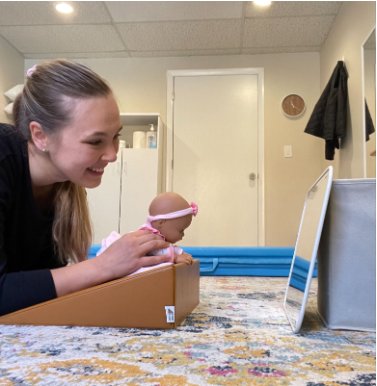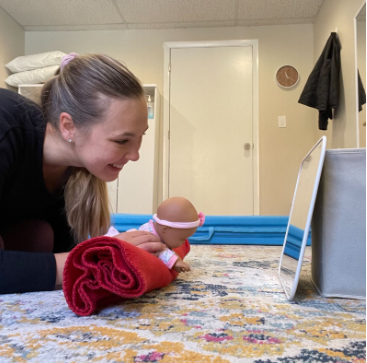Is Tummy Time Actually Important? (The Real Deal from a Pediatric PT)
By Dr. Allison Chisholm, PT, DPT
Disclaimer: This post may contain affiliate links. If you purchase through my links, I may earn a small commission at no extra cost to you. I only recommend products I personally use and love with my own family and clients.
You’ve seen it all over Instagram. You’ve heard it from your pediatrician. Everyone says: “Get your baby on their belly!”—but what’s the deal with tummy time, really?
Is tummy time actually necessary for your baby’s development?
Short answer: Yes, it’s important—but it’s also not the only thing that matters. Let me explain.
What Is Tummy Time and Why Is It Recommended?
Tummy time became a “thing” after the Back to Sleep Campaign (now called Safe to Sleep) launched in 1994 to reduce the risk of SIDS (Sudden Infant Death Syndrome).1 Babies were now sleeping on their backs—which did help reduce SIDS—but led to a rise in:
Plagiocephaly (head flattening): increased by 40%
Delayed gross motor milestones (rolling, sitting, crawling, etc.)2
So, pediatric experts started recommending dedicated tummy time while babies are awake and supervised, especially in the first 6 months of life.3
Benefits of Tummy Time for Babies
Here’s what the research (and my clinical experience) has to say about why tummy time is beneficial:
1. Supports Motor Milestone Development
Babies who spend more time on their bellies tend to roll, sit, crawl, and pull to stand earlier than those who don’t. Some studies show this benefit even lasts through age 3!2
2. Helps Prevent Flat Head Syndrome
More tummy time = less pressure on the back of the head = lower risk of both plagiocephaly and brachycephaly.2
3. Boosts Early Communication
Babies who get more tummy time in the first year often show stronger social and communication skills, but not so much after that first year.2
4. May Support Cognitive Development
Some studies link early belly movement (by 6 months) to stronger problem-solving skills, though research is mixed. Still, movement and play matter.2
5. Can Influence BMI - But Take this One Lightly
One study found babies who spent more time on their bellies at 2 months had a lower BMI at 4 months. That said, BMI isn’t a great measure of baby health (or adult health, for that matter).2
If your baby is thriving in their own unique timeline—large or small, early or later to roll—you’re doing great. Always.
6. May Support Feeding and Digestion - Kind Of
Though not well studied, some believe tummy time supports:
Neck and back muscle strength
Tongue mobility and oral motor function
Improved digestion
But too much focus on the back body (without balancing core strength) can lead to dysfunction. Like Dr. Jill Hitchcock said in a New York Times article:
“What’s most important is that kids be in a variety of positions during the day.”5
As a pediatric PT, I 100% agree.
How Much Tummy Time Should Babies Do?
Here’s the range:
AAP Recommendation: Start with 2–3x per day for 3–5 minutes, working up to 15–30 minutes/day by 7 weeks4
WHO Recommendation: Aim for 30+ minutes daily from the start2
Best outcomes: Studies show more than 30 minutes/day supports stronger head control, limb alignment, and active movement2
My take? Focus on quality over quantity.
Tummy time should be enjoyable and effective. That might mean:
10 seconds on your chest
3 minutes on the floor
5 minutes on a yoga ball
If your baby hates it, the benefits aren’t happening. Start where they are—and where you are mentally—and build from there.
If you love numbers: aim for 30–60 seconds of calm, cry-free tummy time from day one, a few times a day (chest counts!). Then work up to 3–10 minutes per session.
Curious what tummy time looks like at different ages? Check out this post for visuals and tips.
Tummy Time Ideas that Actually Work
1. On You (0-3 Months)
a. Chest-to-chest: Lean back on the couch and let baby rest belly-down on your chest.
b. Bent legs: Sit with knees up and place baby on your thighs (the more you straighten your legs, the harder the it’ll be).
c. Across your lap: Support baby with cheek or elbows down on your thigh.
d. In your arms: Hold baby in “Superman” position or supported along your forearm depending on age.
2. On a Yoga or Therapy Ball
Roll baby forward for more challenge (horizontal = harder) or back for ease (vertical = easier). Try placing them in front of a full-length mirror for increased engagement and tolerance.
3. On a Boppy Pillow
Lay baby on the Boppy with arms tucked under shoulders. Get on the floor to sing, chat, or make silly faces—connection helps tolerance!
4. On a Wedge
Same setup as the Boppy. Use it for short bursts and keep it interactive by getting eye-level with your baby.
5. On the Floor (with Fun Add-Ons!)
Use a $7 full-length mirror placed horizontally or contrast cards to motivate head lifts
Roll up a blanket under baby’s armpits for support
Try an inflatable tummy time water mat for variety
Final Thoughts from a Pediatric PT
Some of the research on tummy time is low-level (lots of parent surveys = bias), but the overall trends are clear:
Variety of positions is key
Tummy time helps with development, but it’s not everything
If you’re in survival mode, skip the guilt
Your baby needs love, food, and a clean diaper. That’s what matters most.
Need help getting tummy time to work for your family?
💻 Book a virtual pediatric wellness assessment with me at The Moving Peanut—I'd love to help.
📞 Schedule your FREE 15-minute inquiry call to see if working together would be a good fit for you and your little one.
References
Hewitt L, Kerr E, Stanley RM, et al. Tummy Time and Infant Health Outcomes: A Systematic Review. Pediatrics. 2020;145(6):e20192168
Wen LM, Baur LA, Simpson JM, Rissel C, Flood VM. Effectiveness of an Early Intervention on Infant Feeding Practices and “Tummy Time”: A Randomized Controlled Trial. Arch Pediatr Adolesc Med. 2011;165(8):701–707. doi:10.1001/archpediatrics.2011.115
https://www.nytimes.com/2020/04/13/parenting/baby/tummy-time.html









